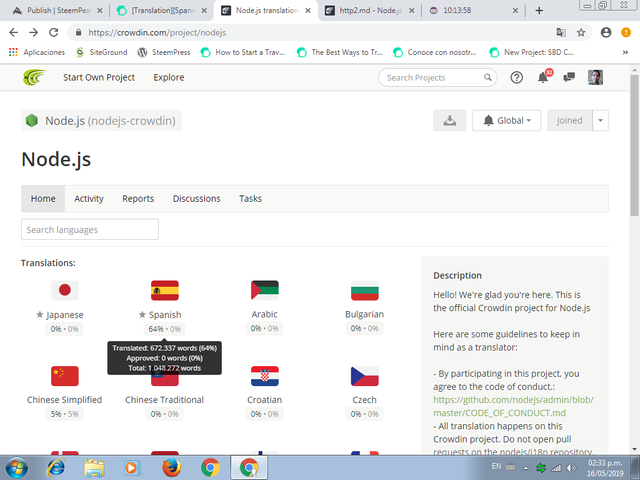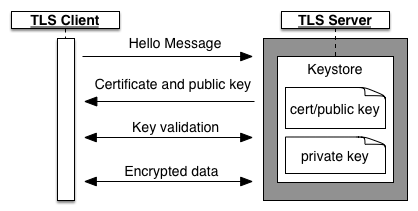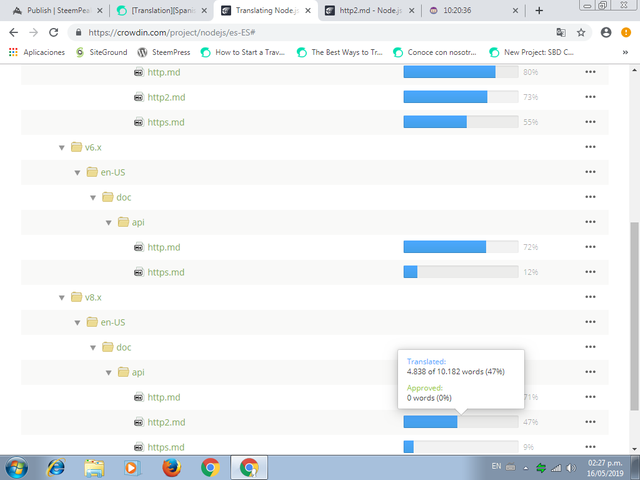[Translation][Spanish] Node.js (1058 words) (Part 42)
Project Details

Node.js is an open-source, cross-platform JavaScript run-time environment that executes JavaScript code outside the browser.
Node.js brings event-driven programming to web servers, enabling development of fast web servers in JavaScript. Developers can create highly scalable servers without using threading, by using a simplified model of event-driven programming that uses callbacks to signal the completion of a task. Node.js connects the ease of a scripting language (JavaScript) with the power of Unix network programming.
In easier to understand words: Node-js is a free platform whose goal is to provide its users the possibility to create lightweight and cost efficient web servers, how does Node.js do this?
Node.js handles web server connections in a way so they don´t take up as much space in a server, and thus, the owner of a project would not need to invest as much money in multiple servers to store so much information in Gigabytes.
Being an Open Source Project, Node.js possesses immense value for providing so much while at the same time being totally free.
Contribution Specifications
672,337 words have been translated so far in the Spanish folder of Node.js, which amounts to a total of 64% done in regards to the completion of the translation of this big project.
Translation Overview
In this contribution, I continued translating the second http2.md folder of Node.js.
"HTTP/2" stands for "Hypertext Transfer Protocol, version 2", which refers to the network protocol used by the World Wide Web, created with the goal of updating the HTTP/1.1 protocol.
HTTP 2.0 doesn't modify the application semantics of HTTP. All of the basic concepts, such as the HTTP methods, status code, URI, and header fields stay unmodified; however, HTTP 2.0 introduces countless updates such as the usage of a single connection, header compression and the ‘server push’ service.
One of the relevant changes introduced by HTTP 2.0 is the removal of redundant information, whose objective is to avoid sending repetitive data during the same connection; thus resulting in decreased consumed resources, achieving less amounts of latency.
According to W3Techs, as of March 2019, 33.9% of the top 10 million websites supported HTTP/2.
In this contribution I found several strings that explain the interactions of the following events: 'aborted', 'request' and 'error'
ENGLISH (1): The <0>'aborted'</0> event is emitted whenever a <0>Http2ServerRequest</0> instance is
abnormally aborted in mid-communication.
SPANISH (1): El evento <0>'aborted'</0> se emite cuando una instancia de <0>Http2ServerRequest</0> se
aborta de manera anormal a mitad de una comunicación.
ENGLISH (2): The <0>'request'</0> event works identically on both <1>HTTPS</1> and HTTP/2.
SPANISH (2): El evento <0>'request'</0> funciona de manera idéntica en <1>HTTPS</1> y HTTP/2.
ENGLISH (3): These will be reported via an <0>'error'</0> event on the <0>Http2Session</0> or HTTP/2 Server objects.
SPANISH (3): Estos serán reportados por medio de un evento de <0>'error'</0> en el <0>Http2Session</0> u objetos del Servidor de HTTP/2.
Examples of short sentences I translated:
ENGLISH (1): Returns <0>'2.0'</0>.
SPANISH (1): Devuelve <0>'2.0'</0>.
ENGLISH (2): Class: http2.Http2ServerRequest
SPANISH (2): Clase: http2.Http2ServerRequest
ENGLISH (3): ALPN negotiation
SPANISH (3): Negociación ALPN
There were also numerous events that reference listener interactions:
ENGLISH (1): If no listener is registered for this event, an <0>'error'</0> event is emitted on the <0>Http2Session</0> instance instead.
SPANISH (1): Si no se registra ningún oyente para este evento, se emitirá en su lugar un evento <0>'error'</0> en la instancia <0>Http2Session</0> .
ENGLISH (2): If no listener is registered for this event, the connection is terminated.
SPANISH (2): Si no se registra ningún oyente para este evento, la conexión será eliminada.
ENGLISH (3): If a [<0>'request'</0>][] listener is registered or [<0>http2.createServer()</0>][] is supplied a callback function, the <0>'checkContinue'</0> event is emitted each time a request with an HTTP <0>Expect: 100-continue</0> is received.
SPANISH (3): Si se registra un oyente [<0>'request'</0>][] o se suministra una función de callback a [<0>http2.createServer()</0>][], el evento de <0>'checkContinue'</0> se emitirá cada vez que una solicitud con un HTTP <0>Expect: 100-continue</0> sea recibida.
The new concept I learned about while working on this subfolder was TLS:

TLS stands for Transport Layer Security.
It is a protocol that provides secure communications via a given network.
The TLS protocol exchanges registries that encapsulate data. These are exchanged in specific formats.
Each registry must be compressed and packaged with a MAC code (message authentication code), this depends on the state of the connection.

In a one-way TLS configuration:
1: The client issues a session request to the server.
2: The server responds with a certificate, which contains its public key. This certificate comes from the server's keystore, which also contains the server's private key. The private key is never sent to the client.
3: For a signed cert, the client makes a request to the Certificate Authority (CA) to authenticates the certificate.
4: The client and server exchange several more messages to validate keys.
5: The client begins TLS data transfer with the server.
References for this concept: 1. 2. 3.
Words translated so far on http2.md

Here's the link to the http2.md folder:
Languages
The project's source language is English and it is being translated into Spanish.
Also, Node.js is currently being translated into other 32 languages. I´m contributing to making this project accessible to the Spanish speaking community online.
Besides collaborating as a translator for Open Source Projects on Crowdin I also work as a Freelance Translator for a law firm in the US, I've been working for that company for one year and five months, translating sworn statements and legal documents from English to Spanish and viceversa.
Open Source Projects I've worked on and contributed to as a translator:
5 . Node.js
Word Count
Part 1: 1016; Part 2: 1026; Part 3: 1035; Part 4: 1092; Part 5: 1050; Part 6: 1147; Part 7: 1133; Part 8: 1049; Part 9: 1090; Part 10: 1093; Part 11: 1024; Part 12: 1102; Part 13: 1085; Part 14: 1049; Part 15: 1035; Part 16: 1059; Part 17: 1041; Part 18: 1114; Part 19: 1114; Part 20: 1033; Part 21: 1030; Part 22: 1059; Part 23: 1047; Part 24: 1070; Part 25: 1151; Part 26: 1039; Part 27: 1025; Part 28: 1035; Part 29: 1063; Part 30: 1037; Part 31: 1047; Part 32: 1023; Part 33: 1041; Part 34: 1064; Part 35: 1060; Part 36: 1052; Part 37: 1055; Part 38: 1064; Part 39: 1066; Part 40: 1071; Part 41: 1051; Part 42: 1058.
Total of words translated so far: 44532.
Proof of Authorship
This translation contribution was submitted via Crowdin on May 11th and May 13th.
For further Proof of Authorship in regards to this contribution you can see my activity on Crowdin here.
Greetings @elpoliglota,
Thank you for submitting your contribution!
Node.js is a very interesting project that contains many code values and terms related to computer science. Its difficulty relies on the fact that we must pay a lot of attention to the code in order to deliver the most accurate translation possible.
Your presentation post includes all the basic information related to the project, interesting concepts and useful examples of your work as a translator.
Regarding your translation, you did a very good job. You used the correct vocabulary and you were careful with code values that should not be translated in order to make sure the text keeps its true meaning.
Keep up the good work :D
Your contribution has been evaluated according to Utopian policies and guidelines, as well as a predefined set of questions pertaining to the category.
To view those questions and the relevant answers related to your post, click here.
Chat with us on Discord
Thank you for your review, @marugy99! Keep up the good work!
Hi @elpoliglota!
Your post was upvoted by @steem-ua, new Steem dApp, using UserAuthority for algorithmic post curation!
Your post is eligible for our upvote, thanks to our collaboration with @utopian-io!
Feel free to join our @steem-ua Discord server
Hey, @elpoliglota!
Thanks for contributing on Utopian.
We’re already looking forward to your next contribution!
Get higher incentives and support Utopian.io!
Simply set @utopian.pay as a 5% (or higher) payout beneficiary on your contribution post (via SteemPlus or Steeditor).
Want to chat? Join us on Discord https://discord.gg/h52nFrV.
Vote for Utopian Witness!